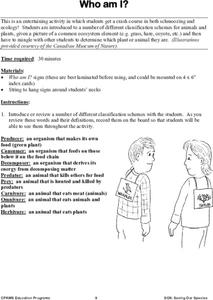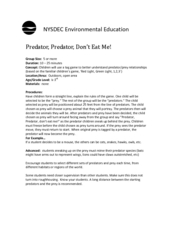Curated OER
Predator vs. Prey
Fifth graders participate in a game to become familiar with predators and preys. In this predator vs. prey lesson, 5th graders ascertain whether a photo shows an organism as a predator or a prey. Students read Killer Creatures....
Desert Discoveries
Sonoran Desert Predators and Prey
Here is a fabulous lesson the animals found in the Sonoran Desert. Learners classify these animals as predators, prey, or both! They take a look at the many adaptations that these animals utilize to help them find food, and avoid...
Curated OER
Predator-Prey Simulation
Students simulate a predator-prey interaction in an ecosystem. Students use different size squares cut from paper to represent predators and prey. They simulate the interactions of the species by following instructions for the capture of...
Curated OER
Who Am I?
Students classify organisms into one of five categories: producer, consumer, decomposer, predator, or prey. Students play a "Who Am I" game. Signs are hung on the backs of fellow students They must ask questions to determine what...
LABScI
Population Dynamics: The Predator-Prey Lab
Wolves eat better when the bunny population increases, but how long does that last? A series of 12 biology lessons uses the sixth installment to explore the predator-prey relationship between bunny and wolf populations. Young scientists...
Howard Hughes Medical Institute
Look Who's Coming for Dinner: Selection by Predation
What happens when a new predator comes to town? Learners analyze an experiment that studies the effect of predation on selection. They use real data to draw conclusions about the impact a new predator has on a prey species.
Curated OER
Predator, Predator, Don't East Me!
To prep for a lesson on predator/prey relationships, get kids up and moving. This game is based on the game 'Red Light, Green Light' but employs the concept of predator vs. prey. This is not a full lesson but could be useful as an...
Curated OER
Web of Predators and Prey
Students investigate the food chain by researching the Internet. In this ecosystem lesson, students view the video "Competitor and Predator" and read a book from the series "The Magic School Bus." Students utilize a worksheet...
Curated OER
Fun With Food Chains
Students explore our ecosystem by researching animal eating habits. In this food chain lesson plan, students identify the links between predator and prey and the energy that passes between organisms based on what their diet consists of....
Curated OER
Peregrine Falcon
Young environmentalists study the effects that pesticides have on birds, such as the peregrine falcon. They also look at predator/prey interactions. Some wonderful in-class activities accompany an inventive lesson. After an activity that...
Curated OER
The Lynx Eats The Hare
Students investigate the predator and prey relationship. This is done using a simple simulation. The simulation is done as an arts and craft activity. Students record data and track it using a graphic organizer and then they discuss the...
Curated OER
Predator-Prey Simulation
Learners simulate the interactions between a predator population of lynx and a prey population of rabbits. They collect and graph the data, then extend the graph to predict the populations for several more generations.
Curated OER
Spider Safari
Today we are talking about one of the stealthiest, sneakiest, and most intriguing insects of all times, the spider. Learners will examine the predatory nature of these super bugs as they conduct a spider safari survey. Each child will...
Curated OER
Leaf Living
Students participate in a game to simulate life on a leaf. In this habitat lesson, students climb under a pile of leaves, some acting as predators and some as prey. Students answer questions related to the game under the leaves.
Curated OER
Birds of Prey
Students research various birds of prey on internet by following a worksheet with specific questions. Students answer questions on worksheet and write short response after completing research.
Curated OER
Carmaleetas
Students identify the relationship between predator and prey in the food chain. In this food chain lesson, students work in groups and play a predator and prey game. Students discover what happens when a predator does not find prey.
Curated OER
Natural Selection
Students examine adaptation through a hands-on activity and determine how the gene pool can affect adaptability. They simulate a predator and prey relationship by going on a hunt for colored acetate disks. After a three minute hunt, they...
Curated OER
Peppered Moth Simulation
Students investigate the process of natural selection in peppered moths. In this natural selection lesson plan, students simulate peppered moths in environments similar to those during the industrial revolution. Students use white paper...
Curated OER
How Many Birds Would It Take To Keep A Jackal Alive?
Students examine the role of large families in some animal populations. They work together to complete an activity related to food supply. They discover the relationship between preys and predators.
Curated OER
Dissecting Owl Pellets
Young scholars dissect owl pellets. In this dissecting owl pellets lesson, students discuss birds of prey and make predictions about what they may find during the investigation. Young scholars tease out skull and bones and try to make a...
Curated OER
Predator-Prey Relationships
Students understand ecological systems. They provide experiences to assist citizens to increase their sensitivity and stewardship for the environment.
Curated OER
Food Web Lab
Students explore the predator-prey interactions and how humans have an impact on the food web. In this food lab lesson students complete a food web activity and discuss what they learned.
Nature Works Everywhere
Sharks and Shorelines
Examine predator-prey marine relationships through an interactive lesson design. Learners begin by studying a specific shark species and then analyze real-time shark-tracking data. They also study threats to shark populations and...
Florida International University
The Good, the Bad and the Nasty Tasting
Examine the benefits of chemical defense mechanisms. Organisms in oceans use chemicals to ward off predators. Duplicate this adaptation using a hands-on experiment in which you ward off your predators (your pupils) with some...
Other popular searches
- Predator Prey Graph
- Predator Prey Relationships
- Predator Prey Game
- Predator Prey Parasite Host
- Predator Prey Population
- Predator and Prey Activities
- Predator Prey Cycles
- Predator and Prey Science
- Predator Prey Interactions
- Predator Prey Relationships
- Predator Prey Simulations
- Predator and Prey Balance

























